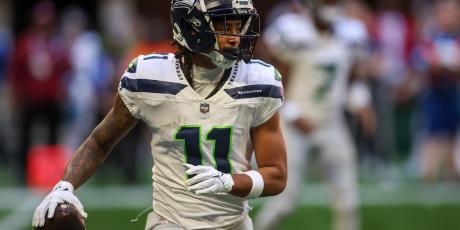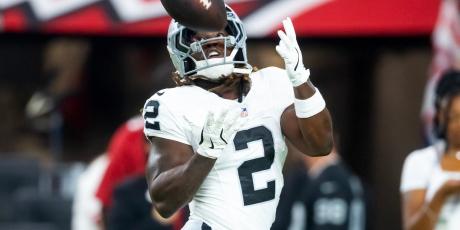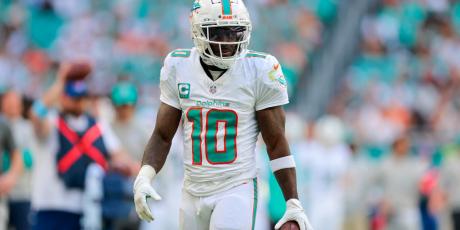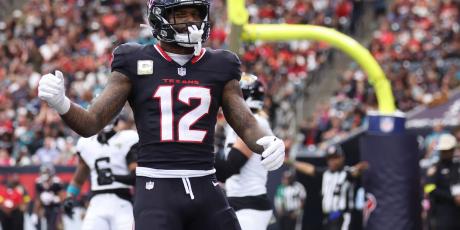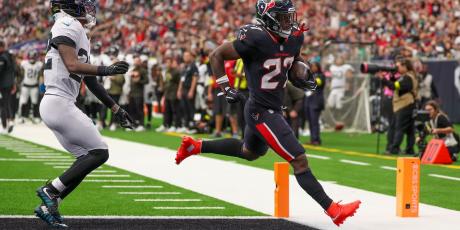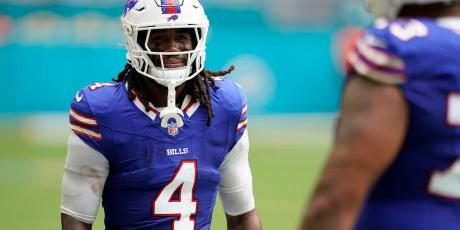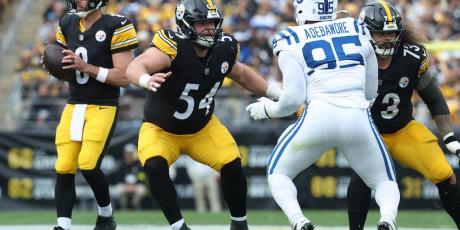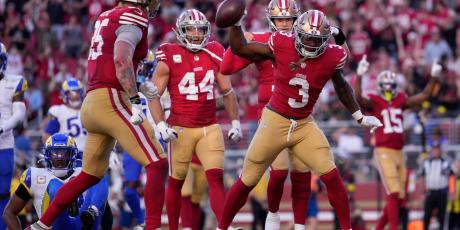Josh Palmer: Late Rising Potential in Los Angeles

A late riser in the draft process, the Los Angeles Chargers selected Josh Palmer with the 77th pick in the 2021 NFL Draft. A curious pick at first glance, Palmer leaves Tennessee without elite production or athletic testing. However, Palmer played in a disastrous Tennessee offense that failed to capitalize on his unique skill set. Now entering an ascending Chargers offense with available targets, Palmer presents a unique discussion for fantasy in 2021.
This piece will take a look at Palmer’s collegiate production and what to expect at the NFL level. From there, we will examine Palmer’s potential fit with the Los Angeles Chargers and determine how this could influence the offense as a whole.
Editor's Note: Read more player profiles from the rest of the 4for4 staff!
Josh Palmer’s Underutilized Skills
Originally a three-star prospect coming out of high school, Palmer immediately saw the field during his time with the Volunteers. While Palmer only contributed nine catches for 98 yards as a freshman, he actually received playing time in nine games. Beyond 2017, Palmer’s career only got more interesting with a struggling Tennessee program.
As a sophomore in 2018, Palmer registered 23 catches, 484 yards, and a pair of scores. However, this did not count as a sophomore breakout with Palmer failing to meet the 20% touchdown threshold. Positively, Palmer showed growth throughout each season with Tennessee. As a senior in 2020, Palmer finished with 33 catches, 475 yards, and four scores. In total this gave him a 21.0 Breakout Age and 25.9% College Dominator. College Dominator refers to the total percentage of receiving yardage and touchdown production a player accounted for in their final season, while Breakout Age refers to the age of a player during their first season accounting for 20% of receiving yards and touchdowns in their offense.
| Opponent | Targets | Rec | Yds | TD |
|---|---|---|---|---|
| South Carolina | 8 | 6 | 85 | 1 |
| Missouri | 6 | 4 | 71 | 0 |
| Georgia | 6 | 3 | 71 | 2 |
| Kentucky | 3 | 1 | 11 | 0 |
| Alabama | 9 | 4 | 57 | 1 |
| Arkansas | 5 | 2 | 28 | 0 |
| Auburn | 6 | 1 | 8 | 0 |
| Florida | 6 | 4 | 36 | 0 |
| Vanderbilt | 5 | 4 | 53 | 0 |
| Texas A&M | 6 | 3 | 55 | 0 |
However, Palmer’s production requires additional analysis. Palmer spent most of his career under the now-fired Jim Chaney. Already running an inept offense, Chaney continued to thrust replacement-level quarterback Jarrett Guarantano onto the field. From there, Tennessee used Palmer almost exclusively as a deep threat. Palmer registered a 17.3 average depth of target (aDOT) in his career at Tennessee. Guarantano completed only 32.3% of his deep passes with many checking in as uncatchable. Even more frustrating, Tennessee refused to use Palmer in the red zone, registering seven career touchdowns. In 2020 alone, Palmer received just seven red zone targets, despite standing 6-foot-1, 210 pounds.
Because of his curious usage, Palmer leaves some questions unanswered. Only 19.4% of his receiving yardage came after the catch, but most of his targets occurred downfield with little accuracy. He also only had one red zone catch combined in the last two years. However, he never received ample scoring chances in Tennessee’s inept offense. Despite the concerns, Palmer only dropped four passes on 164 targets in his Tennessee career, pointing to strong efficiency overall.
Lastly, Palmer displayed a rare ability to win one on one against some of the SEC’s top corners. Palmer registered three catches for 50 yards and a score against Alabama’s Patrick Surtain, who only gave up two scores all year. Palmer also made the most of his trip to the Senior Bowl. Per PFF, no receiver had a higher win rate, drawing comparison to the strides made by Terry McLaurin during his Senior Bowl performance.
Offensive Fit with Los Angeles
Standing 6-foot-1, 210 pounds with a 4.51 40-yard dash, Palmer looks most likely to play on the perimeter at the NFL level. Palmer played 79% of his snaps out wide for Tennessee in 2020, so this remains the smoothest transition. Entering Los Angeles, Palmer will compete with Keenan Allen, Mike Williams, Jalen Guyton and Tyron Johnson for playing time.
Entrenched among the starters, Allen should retain his role in the slot while Williams provides a vertical threat on the boundary. Allen turned in a hyper-productive 992 yards and eight scores on 100 catches in 14 games in 2020, equating to a 26.7% target share. Meanwhile, Williams provided a strong complement with 756 yards and five touchdowns of his own on 48 catches and a 14.5 target share. This leaves Guyton, Johnson, and Palmer to battle for the third wide receiver spot. This position could play an elevated role with Hunter Henry moving to New England and vacating 17% of the targets. However, Los Angeles signed Jared Cook and also has in-house replacement Donald Parham to handle true tight end duties.
With Brandon Staley and Joe Lombardi taking over as head coach and offensive coordinator, Los Angeles expects to use more of a rotation for the last receiver spot, similar to what Lombardi implemented in New Orleans. Both Guyton and Johnson run sub-4.4 40-yard dashes, while Palmer provides more of a contested-catch presence. Still, both Guyton and Johnson stand 6-foot-1 as well, giving the Chargers plenty of size on the boundary. From an efficiency standpoint, Johnson’s 2.44 yards per route dwarfed Guyton’s 0.88 mark after he struggled with drops in 2020.
| Player | Targets | Rec | Yds | TD | aDOT | YAC | Yards/Route |
|---|---|---|---|---|---|---|---|
| Keenan Allen | 138 | 100 | 992 | 8 | 7.3 | 444 | 1.91 |
| Mike Williams | 81 | 48 | 756 | 5 | 15.8 | 154 | 1.56 |
| Jalen Guyton | 52 | 28 | 511 | 3 | 16.4 | 183 | 0.88 |
| Tyron Johnson | 26 | 20 | 398 | 3 | 20.3 | 64 | 2.44 |
| Donald Parham | 20 | 10 | 159 | 3 | 9.9 | 58 | 1.42 |
| KJ Hill | 11 | 7 | 73 | 0 | 6.8 | 22 | 0.78 |
| Joe Reed | 1 | 0 | 0 | 0 | -9 | 0 | 0 |
| Jared Cook | 73 | 46 | 572 | 7 | 11.6 | 135 | 1.55 |
Even with the questions at the WR3 spot, this looks like an offense to invest in. Justin Herbert enters his second season after completing 66.6% of his passes for 4,336 yards, 31 scores, and 7.3 yards per attempt as a rookie. Importantly, the Chargers also upgraded their offensive line with first-round pick Rashawn Slater and free-agent acquisitions Corey Linsley and Matt Feiler. With Lombardi also coordinating some of the most efficient offenses in the NFL with the Saints, the Chargers look like one of the most improved offenses in the NFL.
From a redraft perspective, Allen and Williams continue to provide value at their various ADPs. Williams in particular comes off the board just outside the top 100 picks and looks locked into a role on the perimeter. As for the WR3, Palmer, Guyton, and Johnson are pure speculative dart throws. With this battle likely to play out in the preseason, taking a wait-and-see approach makes the most sense in redraft.
From a dynasty perspective, Palmer holds elevated intrigue. After 2020 rookies K.J. Hill and Joe Reed disappointed, the Chargers invested a day two pick in Palmer. Both Johnson and Guyton came to the Chargers as undrafted free agents, leaving the current coaching staff with little ties to their roster spots. Williams also hits free agency after this season, potentially opening additional playing time for Palmer. Currently, 4for4 dynasty expert George Kritikos ranks Palmer as his WR19 and 33rd overall player in rookie drafts. Kritikos also pegs Palmer as his WR85 and 185th overall player in dynasty startup drafts.
Bottom Line
With the Chargers entering their second year under Justin Herbert, the offensive upgrades make Los Angeles an even more enticing fantasy environment. Behind Allen and Williams, the Chargers' WR3 position remains unsettled. Currently, Palmer, Guyton and Johnson come off the board at picks 210.7, 213.7, and 215.9 on Underdog Fantasy. While this position likely provides value at the back half of drafts, predicting the third receiver for the Chargers remains difficult. For those playing normal best ball drafts, avoiding this position looks like the safest route until one of the receivers emerges as the favorite for playing time.


